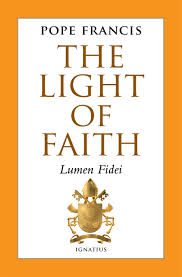 Here is an official summary of Pope Francis’ first encyclical, “Lumen Fidei”, published today, July 5th, 2013 and signed on June 29th of the same year.
Here is an official summary of Pope Francis’ first encyclical, “Lumen Fidei”, published today, July 5th, 2013 and signed on June 29th of the same year.
— — —
Lumen fidei – The light of faith (LF) is the first Encyclical signed by Pope Francis. Divided into four chapters, plus an introduction and a conclusion, the Pontiff explains that the Letter supplements Benedict XVI’s Encyclicals on charity and hope, and takes up the “fine work” carried out by the Pope Emeritus, who had already “almost completed” the Encyclical on faith. The Holy Father has now added “further contributions” to this existing “first draft”.
The introduction (nos. 1-7) of LF illustrates the motivations at the basis of the document: …
Chapter One (nos. 8-22): We have believed in love (1 John 4: 16). Referring to the biblical figure of Abraham, in this chapter faith is explained as “listening” to the word of God, the “call” to come out from the isolated self in order to open oneself to a new life and the “promise” of the future, which makes possible the continuity of our path through time, linked so closely to hope. …
LF then turns to the figure of Jesus, the mediator who opens to us to a truth greater than ourselves, the manifestation of God’s love that is the foundation of faith: “in contemplating Jesus’ death … faith grows stronger”, as in this He reveals His unshakeable love for mankind. His resurrection renders Christ a “trustworthy witness”, “deserving of faith”, through Whom God works truly throughout history, determining its final destiny. ,,,
Chapter Two (nos. 23-36): Unless you believe, you will not understand (Is 7:9). The Pope shows the close link between faith and truth, the reliable truth of God, His faithful presence throughout history. “Faith without truth does not save”, writes the Pope; “It remains a beautiful story, the projection of our deep yearning for happiness”. …
At this point, the Pope begins a broad reflection on the “dialogue between faith and reason”, on the truth in today’s world, in which it is often reduced to a “subjective authenticity”, as common truth inspires fear, and is often identified with the intransigent demands of totalitarianism. …
Chapter Three (nos. 37- 49): I delivered to you what I also received (1 Cor 15:3). This chapter focuses entirely on the importance of evangelization: he who has opened himself to God’s love cannot keep this gift for himself, writes the Pope. …
Fourth chapter (nos. 50-60): God prepares a city for them (Heb 11:16) This chapter explains the link between faith and the common good, which leads to the creation of a place in which men and women may live together with others. …
The Encyclical then considers those areas illuminated by faith: first and foremost, the family based on marriage, understood as a stable union between man and woman. …
Conclusion (nos. 58-60): Blessed are you who believed (Luke 1,45) At the end of LF, the Pope invites us to look to Mary, “perfect icon” of faith who, as the Mother of Jesus, conceived “faith and joy”. The Pope elevates his prayer to Maria that she might assist man in his faith, to remind us those who believe are never alone and to teach us to see through Jesus’ eyes.
Tags: encyclical, Lumen Fidei, Pope

